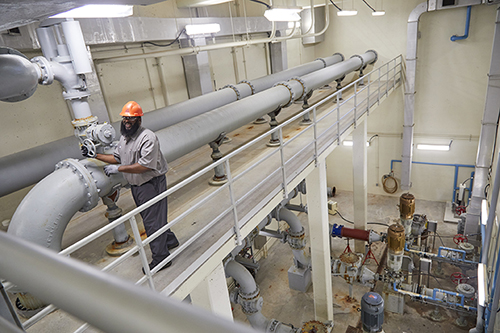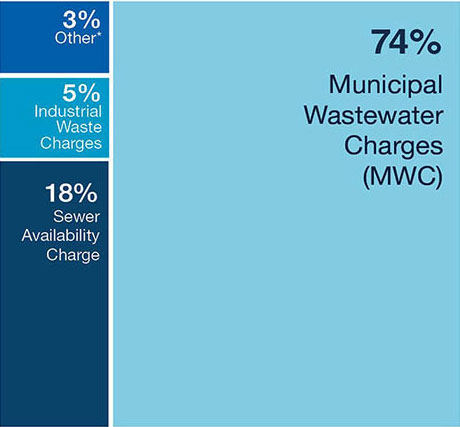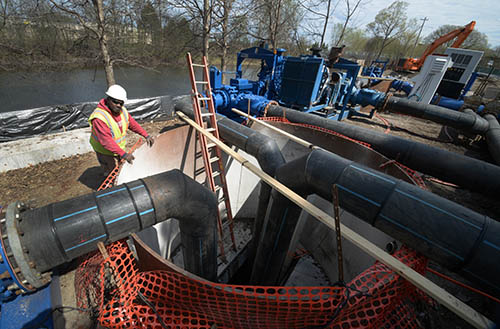 The regional municipal wastewater charge is proposed to rise 2% overall in 2021, Metropolitan Council Environmental Services told its customer cities and townships in May.
The regional municipal wastewater charge is proposed to rise 2% overall in 2021, Metropolitan Council Environmental Services told its customer cities and townships in May.
“When we started our budget planning in February, we were committed to our promise to keep the annual municipal wastewater charge increase to less than 4% through 2022,” said Ned Smith, Director of Finance and Revenue for Environmental Services. “We were looking at 3.7% for 2021, and then the pandemic hit, and we knew that our customers would be facing budgetary challenges. So we made some adjustments to ease what is likely to be a tough year in 2021.”
To hold the increase in the municipal wastewater charge to 2%, Environmental Services will transfer additional funds from the SAC reserve fund to help pay directly for capital improvements, as well as draw $2 million from its general reserve fund.
The per-unit sewer availability charge (SAC), the second largest source of revenue for the regional wastewater treatment system, is proposed to remain flat for the seventh consecutive year.
Charges to customer communities based on flow volume
 The level of increase or decrease in the municipal wastewater charge that any given city or township will pay is based on its share of the overall wastewater volume treated by Environmental Services. Allocations for 2021 are based on flow volumes from 2019.
The level of increase or decrease in the municipal wastewater charge that any given city or township will pay is based on its share of the overall wastewater volume treated by Environmental Services. Allocations for 2021 are based on flow volumes from 2019.
Since 2019 was the wettest year on record in the Twin Cities metro area, cities with excessive inflow and infiltration (I/I) of clear water into the wastewater system will face larger rate increases than others, explained Kyle Colvin, Manager of Engineering Programs. Cities without excessive I/I could see a smaller increase or even a sizable decrease in their charge.
SAC reserve fund in good shape
The sewer availability charge is made to residential, commercial, and industrial properties that connect to the regional wastewater system for the first time or that expand or change use in a way that increases demand for capacity in the wastewater system. The regional SAC has remained at $2,485 per unit since it was last raised on Jan. 1, 2014. SAC revenues are put into a reserve fund to pay a portion of the debt service for the wastewater system.
SAC revenue has grown from 6,653 units purchased at a low point in 2009 to 25,308 units in 2019, the greatest number in the last two decades. The SAC reserve fund is healthy, making it a good tool “to help us through the coming slowdown,” Smith said.
The number of SAC units that builders and remodelers are requesting is down about 15% so far this year, but some indicators show there will be less of a reduction in residential construction, he said.
Wastewater operations funded entirely by user fees
 Environmental Services proposes $323 million in revenue for 2021, nearly three-quarters (74%) of which is the municipal wastewater charge. Another 18% will come from the SAC reserve fund, 5% from industrial waste charges, and 3% primarily from interest payments and use of reserves.
Environmental Services proposes $323 million in revenue for 2021, nearly three-quarters (74%) of which is the municipal wastewater charge. Another 18% will come from the SAC reserve fund, 5% from industrial waste charges, and 3% primarily from interest payments and use of reserves.
The regional wastewater collection and treatment system is entirely funded by user fees. Wastewater revenues, by law, cannot be spent on any other Council functions. Conversely, transit fares or other Council revenues cannot support wastewater operations or capital improvements.
Nearly half (48%) of the wastewater budget is for debt service, and another 23% for salaries and benefits for the 703 full-time equivalent jobs. Additional spending (6% each) is for consulting and contractual services; materials, supplies, and chemicals; interdivisional services (like procurement and human resources); and rent and utilities. The remainder of expenses are cash payments for capital projects (3%) and other (2%).
Council invests in asset preservation
 Debt service is the largest portion of the wastewater budget because Environmental Services spends, on average, about $150 annually to preserve, improve, and expand its estimated $7 billion in wastewater infrastructure — regional sewer interceptor pipes, lift stations, flow meters, and nine wastewater treatment plants.
Debt service is the largest portion of the wastewater budget because Environmental Services spends, on average, about $150 annually to preserve, improve, and expand its estimated $7 billion in wastewater infrastructure — regional sewer interceptor pipes, lift stations, flow meters, and nine wastewater treatment plants.
Capital spending will increase in the next three years to $175-180 million annually because of a large project associated with solids management at the Metro Plant in Saint Paul. In addition, Environmental Services is improving solids management capacity and increasing energy recovery at the Empire Plant, among many other treatment plant and interceptor rehabilitation projects.
Capital projects are financed by a combination of low-interest (1.5% most recently) Public Facilities Authority loans, Council general obligation bonds, and a small portion of cash payments. The Council has a AAA bond rating and receives low interest rates on its bond payments, 1.65% for the most recent $80 million bond sale.
Rates continue about 40% below the national average
Our regional wastewater system provides great value to customers, Smith noted. The most recent survey of retail rates for households in the Council’s wastewater service area shows that combined regional and local wastewater fees for Twin Cities area retail customers average $274 annually. That’s 40% below the national average for agencies that treat more than 100 million gallons per day, according to the National Association of Clean Water Agencies.
Rates will be adopted in July
Environmental Services has shared with each municipal customer their individual municipal wastewater charge for 2021. On May 21, MCES shared its rates, customer portal, and capital program details with over 50 people at its budget forum webinar. A second budget webinar with customers is set for Thursday, June 11.
The Council’s Environment Committee will consider the proposed rates at its July 14 meeting, followed by Council action on July 22. The rates are used to set the Council’s preliminary 2021 budget, which is adopted for public comment in August and finalized for approval in December.